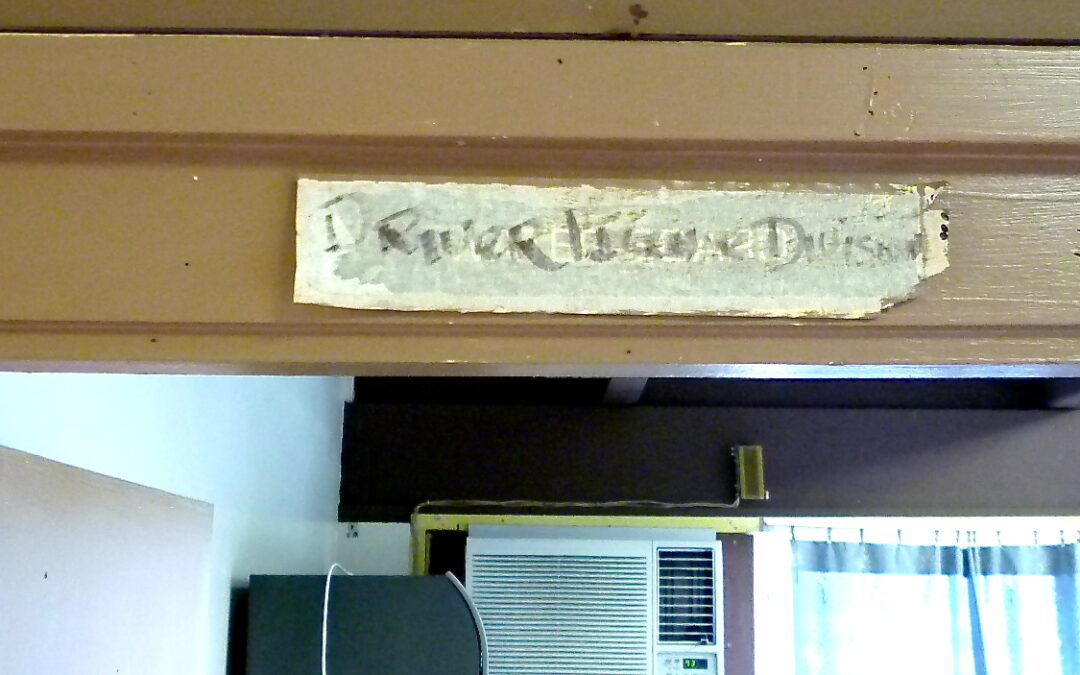 The tattered, barely readable words in black ink written on top of another illegible sign is scotch-taped above the multi-painted brown door. “Driver License Division” announces that you are at the right place. An old school-house desk sits just outside the open door revealing a closet-sized office and the happy, smiling Hana “Driver License” lady, Leimomi (which means string of pearls in Hawaiian). “Next victim,” she giggles.
The tattered, barely readable words in black ink written on top of another illegible sign is scotch-taped above the multi-painted brown door. “Driver License Division” announces that you are at the right place. An old school-house desk sits just outside the open door revealing a closet-sized office and the happy, smiling Hana “Driver License” lady, Leimomi (which means string of pearls in Hawaiian). “Next victim,” she giggles.
Resident drivers in the state of Hawaii are required to take a written test. Yes. Hawaii is the 50th state and it actually uses American currency and has the same governmental rules and regs. Just don’t think that because you move to Maui that you can drive your Woody, wave wagon or 4-Runner around with a California “Dreamin” driver’s license in your wet suit. You’d be dreamin’.
So as a public service, I’m going to provide a brief tutorial. I visited the internet “Home Page” from the Hawaiian Dept. of Transportation. They tell me that I can study all of the 171 practice test questions. Now..first off..what’s with the 171? Why can’t it be an even number like 180 divisible by 30=6 tests. If you divide 171 by 30, you get 5.7 tests to practice on and that means you’re short-changed on one of them and dontcha know those will be the very questions showing up on your “for real, fail or go to jail” test. Couldn’t they think of 9 other questions? Or less? 171 is a lot of questions. Oh wait..the Home Page says that it’s providing 12 different tests for me to practice on. All-righty then–just make it 168 questions divided equally makes 14 tests to practice on. Geez! Now for the final warning: “You can only miss 5 questions.” 5 questions?! How about 6 questions–a 20% flub-rate would be a normal ‘B’ grade–right? Okay, so here goes:
 Instructions: “All questions are multiple-choice. Each answer in this interactive test have explanations why something is right or wrong.” (That sentence needs a grammatical touch-up.) And I don’t need an explanation if I get the answer right for heaven’s sake–I get it. “Therefore you will be learning as you take the test. Good luck.” Of course, they wish me good luck because then I’ll write a check to the Dept. of Finance for $22.
Instructions: “All questions are multiple-choice. Each answer in this interactive test have explanations why something is right or wrong.” (That sentence needs a grammatical touch-up.) And I don’t need an explanation if I get the answer right for heaven’s sake–I get it. “Therefore you will be learning as you take the test. Good luck.” Of course, they wish me good luck because then I’ll write a check to the Dept. of Finance for $22.
Now here are the for-real, I’m not kidding, honest-to-God questions. The only answer that’s not for real is #5 (that’s my obvious suggested answer). Let’s get started:
#14. The boss chews you out just before quitting time. You don’t say much, but You think he is unfair and You are angry! When You get to your car you should:
1. Play the radio loud, so You won’t think about it.
2. Drive fast on the Interstate so You can let off steam.
3. Take a few minutes to cool off before You drive home.
4. Stop in your favorite bar and have a few drinks before driving home.
5. Start looking for another job.
P.S. The state’s “comments” says: “Better to be ‘cooled off’ as a live person than to be a ‘cold’ dead body in a morgue.
#43. Certain highway signs and markings require that you must obey the indicated instruction. Such signs are known as:
1. Regulatory signs.
2. Information signs.
3. Warning signs.
4. Guide signs.
5. Who the heck cares what kind of sign it is. If the sign says “Stop,” Stop! Just obey it already.
#51. Edgelines are solid____or____lines along the edges of the roadway to be used as a safety quide to mark the limits of the traveled way.
1. Yellow; white
2. Orange; white
3. Red; white
4. Green; white
5. They could be bright blue;white for all we care. Just don’t drive over the edge and off the cliff.
#71: Pedestrian signals consist of the lighted words “WALK” and “DON’T” WALK” and the symbols of a walking person and an upraised palm. A steady “DON’T WALK” or upraised palm signal means:
1. Pedestrians must not enter the roadway toward the signal.
2. Pedestrians already in the intersection facing the signal may continue to the nearest sidewalk, traffic island or safety zone.
3. Pedestrians already in the intersection facing the signal must RUN to the nearest sidewalk.
4. Both 1 and 2 above.
5. It says “DON’T WALK”! If you can’t read that, you probably need to enroll in a state literacy class.
#88. A few drinks after work before driving home:
1. Is good because you miss the rush hour traffic.
2. Is good because they help to release the day’s tension and make you a safer driver.
3. Should be avoided because they may make you a dangerous driver.
4. Never hurt anyone.
5. Is good because it’s answer #4 in question #14.
#94: Drugs may interfere with a person’s ability to drive safely:
1. Only if the drugs are prescribed by a doctor.
2. Only when taken while drinking.
3. Only when driving at night.
4. And it is important to ask your doctor about any effects that the prescribed drugs may have on your driving ability.
5. And it is important to ask your doctor if he drinks and takes drugs.
#96. The effect that alcohol has on your reflexes and judgment:
1. Is less if you were only drinking beer.
2. Is less if you were only drinking wine.
3. Is greater if you were drinking whiskey or hard liquor.
4. Depends on the amount of alcohol in your blood stream.
5. Is less if you drive home really fast before the alcohol has a chance to take effect.
#103. You are driving behind another vehicle. You notice that the driver is driving with one hand, talking to a passenger. You as a driver:
1. Know that you should give the vehicle ahead extra room.
2. Know that the driver in the vehicle ahead is reducing his safety margin by being an inattentive driver.
3. Know the you should avoid this bad habit.
4. All of the above.
5. Know that the driver could be an amputee and is missing a hand.
#105. An arrogant driver is a driver who:
1. Is purposely in a hurry, competing with other traffic,
2. Shows little or no respect for traffic laws, or the way of others.
3. You should try to avoid when driving.
4. All of the above.
5. Drives a Lamborghini Aventador or a Ferrari F12berlinetta or a Hummer H1.
#137. You wish to exit the freeway, but have missed your exit ramp. You should:
1. Back up on the shoulder to get onto your exit ramp.
2. Turn around on the shoulder and drive on the shoulder to your exit.
3. Cut across the grass to your exit.
4. Continue driving to your next exit.
5. Say “Oh #*%#!” because you know your next exit is ten #*%#ing more miles down the road.
#148. You are driving down a hill and notice a heavy vehicle fast approaching from behind. You should:
1. Pay no attention as heavy vehicles always speed down hills.
2. Know that you have the right of way and it is the truck driver’s responsibility to miss you.
3. Know that you may have to move out of the heavy vehicle’s way.
4. Drive on the right side of the highway and slow down.
5. Be grateful you’re not on the Los Angeles’ #405 or you’ll be dead.
#149. When passing a large vehicle a driver of a small vehicle must be prepared for:
1. A loud noise.
2. Excess air pollution.
3. Wind gusts produced by the large vehicle.
4. Falling vehicle parts.
5. Overflowing cement or roofing tar, flying asphalt or possible oil tanker explosion.
Now these sample questions above are just a dozen out of the 171. The good news is that I only missed one answer out of 30 for a .033333% error rate. And what is the question that I flubbed, you might ask. Here it is:
 #44. Certain highway signs and markings contain information about hazardous conditions. Such signs are known as:
#44. Certain highway signs and markings contain information about hazardous conditions. Such signs are known as:
1. Regulatory signs.
2. Information signs.
3. Warning signs.
4. Guide signs.
Isn’t this the same question as #43? Not quite. Well, question #44 says that the signs contain information, so I put an “X” on answer #2. Wrong! Do not pass “Go.” It’s answer #3. So I’m here to warn you. Be sure to study up before taking your driving test in the ‘Aloha State.’ The friendliest thing about my DT experience was Leimomi, the Hana “Driver License” lady. You’re going to love her laugh (when you get a wrong answer) and her hours are posted.




 Lorraine is a former needlecraft designer who formed her own company (Fingerworks, Inc.)
during the 1970’s and 80’s. With this marketing experience, she ventured back into her chosen
field of film and television and rose up the ranks as an executive with Warner Bros. (Time-Warner). She is also a landscaping professional, author, humorist and artist. She has published four books: “The Tale of Peeky Peeper” (a fun children’s rhyming Holiday book, which she also illustrated); followed by her humorous memoir, “A Nobody in a Somebody World: My Hollywood Life in Beverly Hills.” Playfulness is the theme in whatever she does, as you’ll see in the two versions of her puzzle-like charted coloring books: “Griddles.” When she’s not creating something, you’ll find this 82 year-old grandma whacking a Pickle Ball, teaching movie
history, testing new recipes on her husband, Tom, or serving on the board of the Del Webb Performing Arts Center in Wickenburg, AZ.
Lorraine is a former needlecraft designer who formed her own company (Fingerworks, Inc.)
during the 1970’s and 80’s. With this marketing experience, she ventured back into her chosen
field of film and television and rose up the ranks as an executive with Warner Bros. (Time-Warner). She is also a landscaping professional, author, humorist and artist. She has published four books: “The Tale of Peeky Peeper” (a fun children’s rhyming Holiday book, which she also illustrated); followed by her humorous memoir, “A Nobody in a Somebody World: My Hollywood Life in Beverly Hills.” Playfulness is the theme in whatever she does, as you’ll see in the two versions of her puzzle-like charted coloring books: “Griddles.” When she’s not creating something, you’ll find this 82 year-old grandma whacking a Pickle Ball, teaching movie
history, testing new recipes on her husband, Tom, or serving on the board of the Del Webb Performing Arts Center in Wickenburg, AZ.